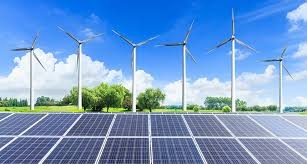As the government continues to focus on increasing the share of renewable energy in the country, nearly 15,000 MW of wind-solar hybrid capacity is expected to come up over the next five years, Crisil said. Out of this 15,000 MW, works on nearly 10,000 MW are already either under construction or are being tendered and are expected to start feeding the grid by fiscal 2024.
In the hybrid option, the system is designed using solar panels and small wind turbines generators for generating electricity.
“We expect the hybrid market to grow and evolve as the number of projects and developers who seek to unlock value from the hybrid increases. Riding on strong support from central public sector undertaking Solar Energy Corporation of India and several state governments, we expect nearly 15,000 MW of hybrid capacity will come up over the next five years,” Crisil Director Rahul Prithiani said.
According to the ratings agency, since generation of solar energy tends to peak during the day and that of wind energy at night, the resulting intermittence in supply impacts grid resilience, making discoms reluctant to buy power from standalone wind and solar projects.
“In the hybrid option, however, these two energy sources complement each other, which could help overcome the problems of variability of generation and grid security, and thereby discoms’ reluctance,” Crisil said.
As of March 2020, India had 37,690 MW of standalone wind energy capacity and 35,000 MW of solar capacity.
The agency further said that currently there are proposals to set up 3,900 MW of pure-play hybrid projects, and another 4,500 MW of hybrid projects with energy storage systems.
“The projects with storage are capable of catering to peak load generation, besides improving the capacity utilisation factor. Hence, these have the potential to reduce the country’s dependence on gas and pumped hydro-based peaking plants,” it said.
In addition, Crisil expects 1,100 MW of hybrid projects to come up as part of 5,400 MW projects under the government’s round-the-clock or RTC power scheme, which has a mandatory 51:49 blend of renewable energy and thermal.
However, the agency noted that availability of good sites with strong irradiation and high wind speeds would be a key challenge, as evident in waning developer interest in wind energy sector.
Along with this, pricing will be a key factor for success of wind-solar hybrid projects.
“We expect hybrid tariffs to be in the Rs 2.8-2.9 per unit range, with a wind-heavy hybrid configuration. We believe the pricing will become more competitive if the co-location clause (necessitating the wind and solar components to be located at the same place) is removed,” Crisil Associate Director Pinal Mehta said.
In the case of hybrid projects with storage capacity, Crisil believes the weighted average tariff (peak and off-peak) of Rs 4.04- 4.30 per unit, as discovered in recent bids, is competitive with thermal power tariffs, which are at Rs 4.4 per unit.
“Also, land availability and policies such as co-location will remain key monitorables for the viability of hybrid projects. Other challenges, including adequate transmission infrastructure and technical issues such as grid balancing would need to be addressed, too,” the agency added.

